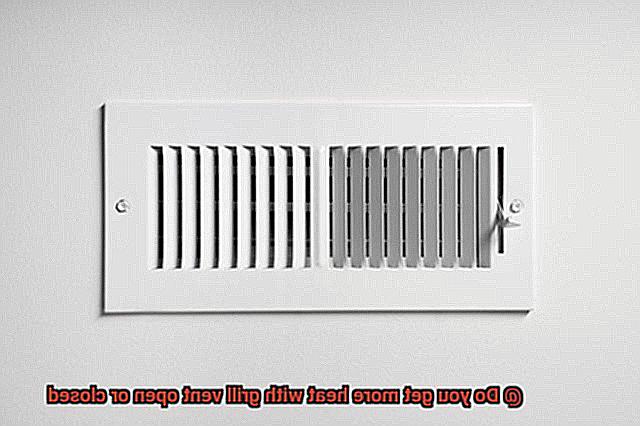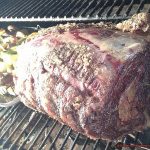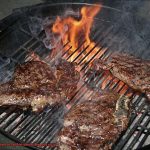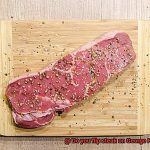Summer is here, and that means it’s time to fire up the grill and get cooking. As you prepare for your next backyard barbeque, you might find yourself asking a common question among grill enthusiasts: “Do you get more heat with grill vent open or closed?”
This debate has been raging for years, with passionate arguments on both sides. Some swear by keeping the vent open to fuel the flames and increase the temperature. Others believe that closing the vent traps heat inside and creates a convection effect for even cooking.
But what’s the science behind this heated discussion? In this blog post, we’ll explore how oxygen impacts temperature and why convection cooking can be beneficial. By the end, you’ll have all the information you need to make an informed decision about whether to keep your grill vent open or closed. So grab a cold drink, settle in, and let’s dive into the world of grilling.
Contents
Understanding How Vents Work on a Grill
Grilling is more than just cooking food over an open flame; it’s an art that requires precision, patience, and knowledge of your grill’s components. One such component that plays a crucial role in the grilling process is the vents.
Vents are the gatekeepers of your grill, controlling the amount of oxygen that enters or exits, affecting the temperature and intensity of the heat. There are two types of vents: intake vents and exhaust vents.
Intake vents are located at the bottom of the grill and allow oxygen to flow into the grill, fueling the fire. Meanwhile, exhaust vents are located at the top of the grill and release hot air, smoke, and gases out of the grill. By opening or closing these vents, you can control how much heat your grill generates.
If you want to increase the heat on your grill, keep the intake vents open and the exhaust vents closed. This will allow more oxygen into your grill, fueling the fire and increasing the temperature. Conversely, if you want to decrease the heat on your grill, keep the intake vents closed and the exhaust vents open. This will allow more hot air, smoke, and gases to escape from your grill, lowering the temperature.
However, every grill is unique, so you’ll need to experiment with your specific grill to find out what works best for you. For example, if you’re searing steaks or cooking burgers that require high-heat cooking methods, keeping the vent open can help achieve higher temperatures. On the other hand, if you’re smoking or slow-roasting meat, keeping the vent closed can help maintain a steady temperature over a longer period.
But, external factors such as wind and humidity can also impact how much heat your grill generates with its vents open or closed. Windy conditions can cause a drop in temperature by blowing away heat from the grill. Meanwhile, humidity can make it harder for moisture to evaporate from your food and contribute to lower temperatures.
High-Heat Cooking Methods and Vent Openness
Understanding the role of vent openness is crucial in achieving perfectly cooked and flavorful meals every time. As an expert in this area, I’m here to share some tips and tricks on how to use your grill’s vents to take your grilling game to the next level.
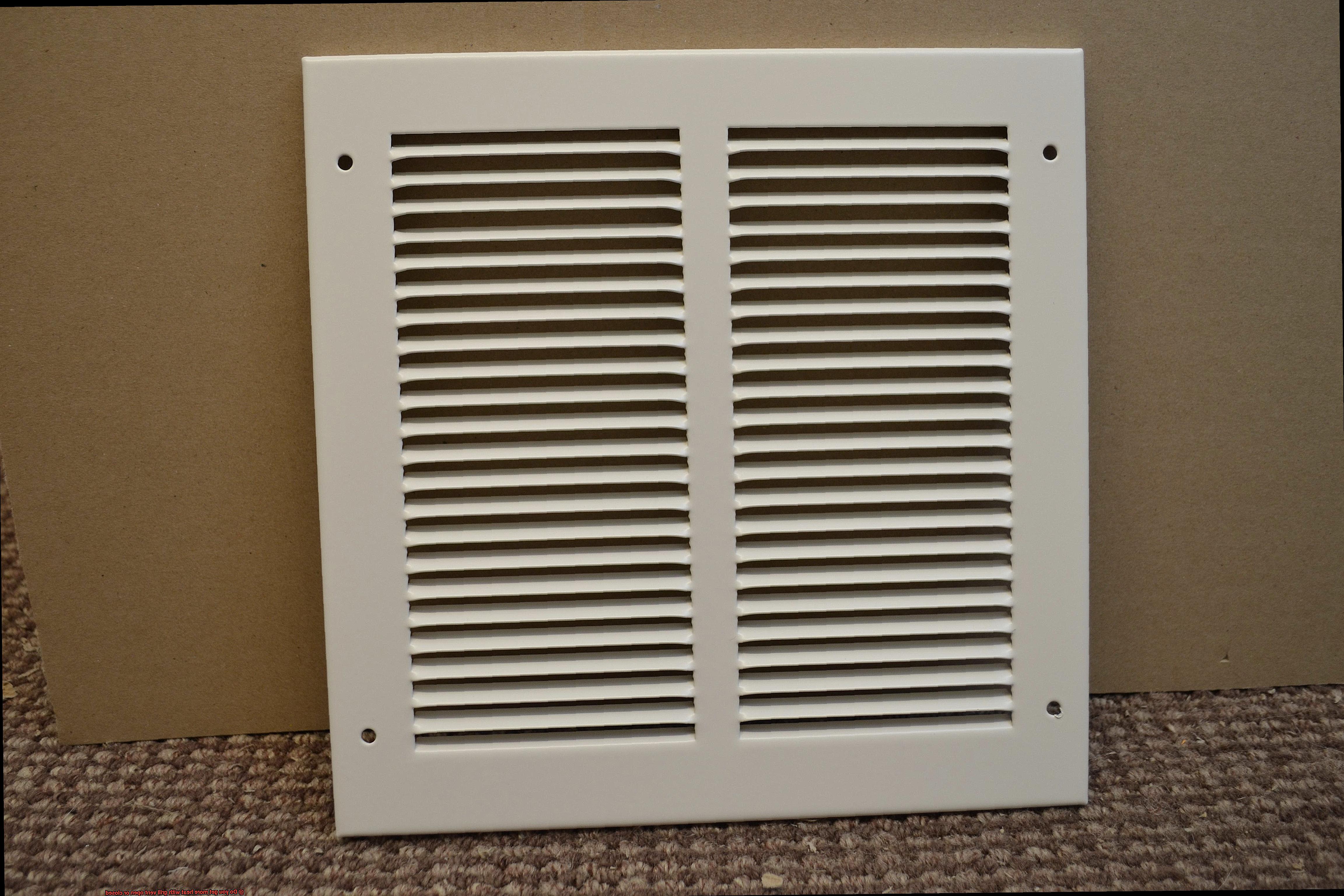
Firstly, let’s define the vent or damper. It’s a small opening located on the lid or bottom of your grill that regulates the amount of oxygen reaching the fire. This, in turn, affects the intensity of heat and flames produced. Proper airflow is key to maintaining a consistent temperature throughout the cooking process when it comes to high-heat cooking methods like grilling.
So, what should you do with your grill’s vent when grilling at high temperatures? In general, it’s best to keep it open. This allows for proper air circulation and prevents the fire from being starved of oxygen, which can result in uneven cooking and decreased heat. However, there are some exceptions. For example, if you’re searing a steak or cooking other quick-cooking proteins on a grill, closing the vent can create a more intense heat source and help you achieve a nice crust on the outside of the food.
Moreover, it’s essential to consider the type of grill and fuel source you’re using. Charcoal grills tend to benefit from having the vent open more often than gas grills as charcoal requires more airflow to maintain a consistent temperature. Whether you’re using gas or charcoal, experimentation with different cooking methods and adjusting the vent as needed is always a good idea.
Lower Temperature Cooking Methods and Vent Openness
For example, when utilizing the low and slow method, maintaining a temperature of around 225-250°F, keeping the vents closed can create a smokier flavor that permeates the meat. The smoke is trapped inside the grill, circulating around the meat and infusing it with flavor, resulting in a mouth-watering dish.
However, it is essential to avoid keeping the vents closed for too long as this can lead to a buildup of smoke and heat, causing overheating and overcooking. To regulate the temperature and prevent burning, opening the vents slightly may be necessary.
When using higher temperature cooking methods such as grilling steaks or burgers at around 400-450°F, opening the vents can help increase heat output and cook your food faster. By allowing more oxygen into the grill, flames are fueled, and heat is increased.
However, leaving the vents wide open for too long can cause food to cook too quickly and unevenly. It is vital to monitor your food closely and adjust the vent openness as needed to achieve optimal results.
To summarize, adjusting vent openness is crucial when grilling. For lower temperature cooking methods, keeping the vents closed enhances flavor but requires careful monitoring to prevent overheating. For higher temperature cooking methods, opening the vents increases heat output but also requires careful monitoring to prevent overcooking.
Remember to find the right balance for your specific dish and grill setup.
External Factors That Affect Heat with Vent Open or Closed
Grilling is an art that requires a delicate balance of heat and timing. With so many external factors at play, achieving perfection can be a daunting task. However, by understanding how weather, fuel type, grill size, and shape affect the heat generated when the vent is open or closed, you can elevate your grilling game and produce mouthwatering meals every time.
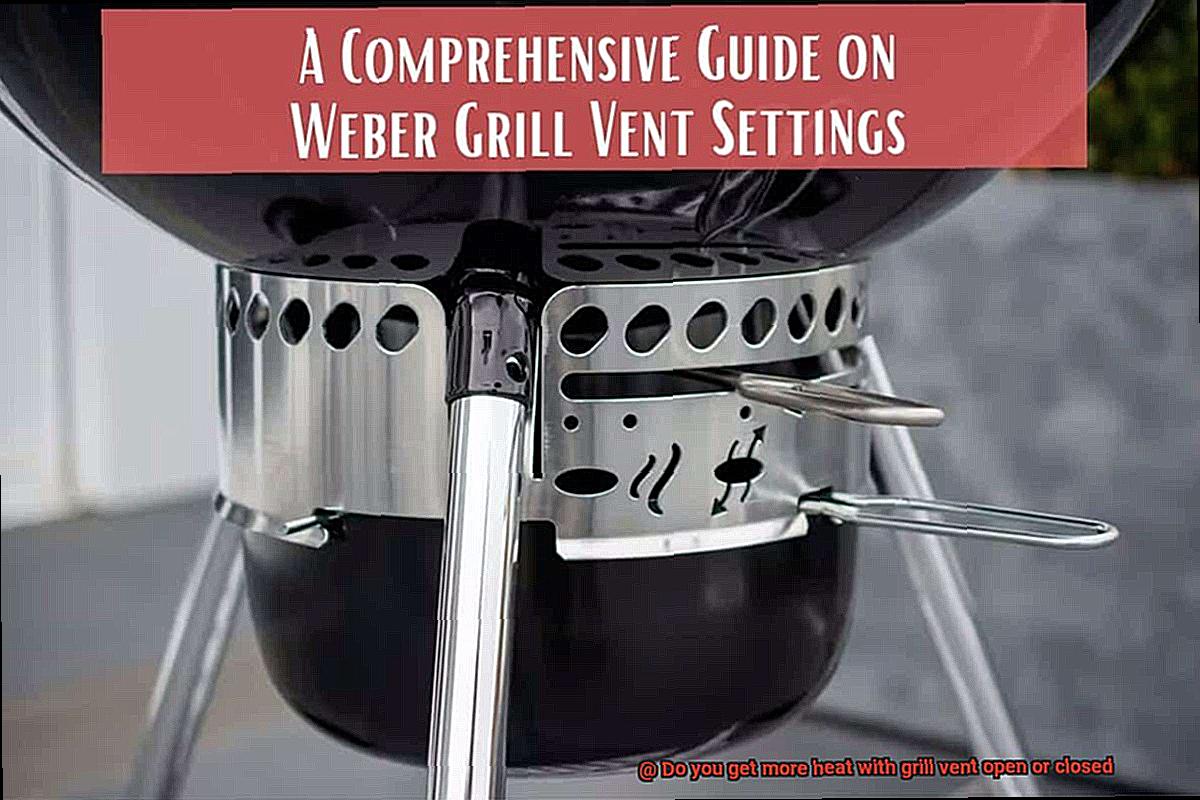
The first factor to consider is the weather. On windy days, keeping the vent open can be detrimental to your grilling game as the wind can blow out the flames and reduce the amount of heat generated by your grill. Conversely, on still days, leaving the vent open can help circulate hot air around your food and cook it more evenly. So, keep an eye on the forecast and adjust your grill accordingly.
The type of fuel you use also plays a crucial role in determining how much heat you get with the vent open or closed. Charcoal grills tend to produce more heat with the vent closed as they rely on a buildup of heat to cook food evenly. On the other hand, gas grills require a steady flow of air to maintain a consistent temperature. Leaving the vent open on a gas grill can help increase the heat output and cook your food faster.
The size and shape of your grill can also affect how evenly your food cooks. Larger grills have more space for air to circulate, which helps distribute heat evenly throughout the cooking surface. In contrast, smaller grills may require the vent to be left open to prevent a buildup of heat that could cause uneven cooking.
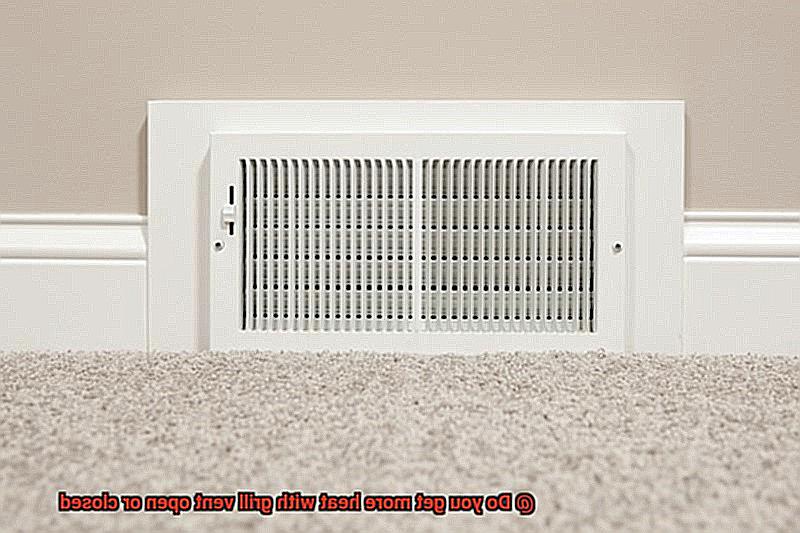
Lastly, finding what works best for your specific model requires experimentation. Every grill is different, so it’s worth trying out different settings and techniques to optimize your grilling experience. By taking these external factors into account and adjusting your grill accordingly, you can ensure that your food is cooked perfectly every time.
Experimenting With Different Settings and Techniques
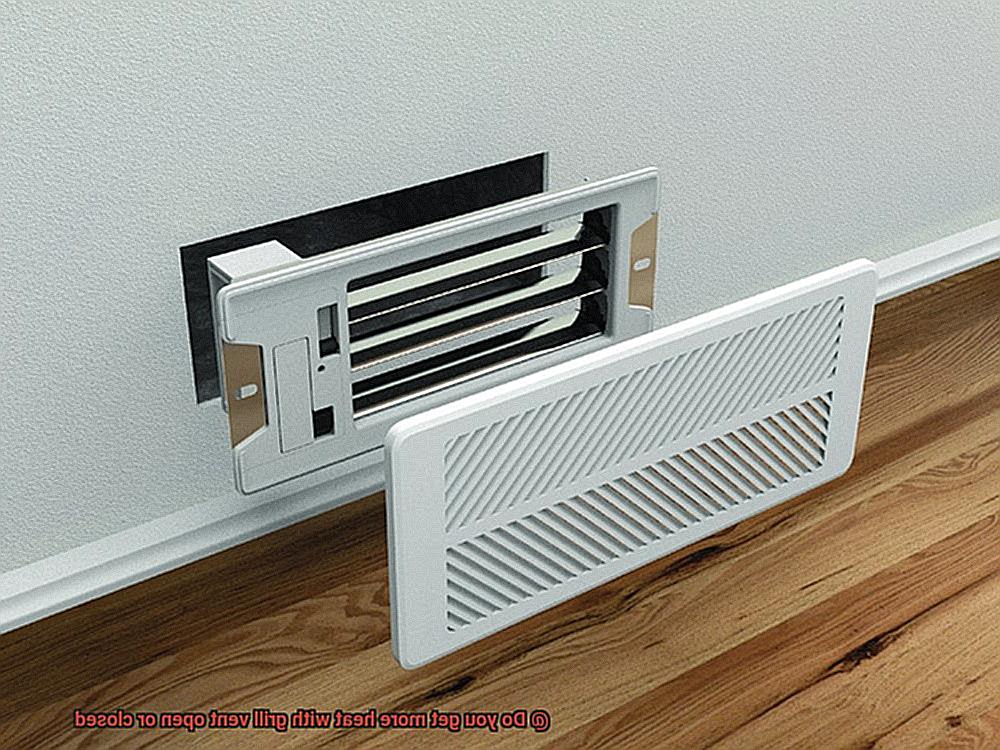
The key to producing mouthwatering meals every time is by experimenting with different settings and techniques.
One of the most critical factors that affect the heat output of a grill is the type of grill used. Charcoal grills require vents to be open to allow oxygen to reach the coals and increase the temperature. However, closing the vents can also help control the temperature and slow down the cooking process. Gas grills, on the other hand, usually have adjustable burners that can control the heat output. Keeping the vents open or closed may not have a significant impact on temperature but can affect cooking time and evenness.
It’s not just grill type that matters; fuel type plays a crucial role too. Charcoal grills produce a more intense heat than gas grills but require more attention and skill to maintain a consistent temperature. Gas grills, meanwhile, are easier to use and maintain but may not produce the same smoky flavor as charcoal grills.
Cooking methods also come into play when determining heat output. Direct heat grilling requires vents to be open to maintain high temperatures for searing meat. Indirect heat grilling, where food is cooked away from the flames, may require vents to be partially closed to control the temperature.
When it comes to experimenting with different settings and techniques, there are a few things you can try. Start by keeping an eye on the forecast since weather conditions can affect heat output. Then, try out different fuel types and experiment with different cooking methods.
To get started, it’s recommended to start with vents open and adjust as needed for optimal heat output and cooking results. By experimenting with different settings and techniques, you’ll be able to find what works best for your specific grill and cooking needs.
Tips for Keeping the Grill at the Right Temperature
Grilling is a fantastic way to cook food, but it can be tricky to maintain the right temperature. Keeping the grill at the perfect temperature is essential for ensuring that your food cooks evenly and thoroughly. Here are some tips for using your grill vents and lid to make sure your food cooks to perfection:
Understanding how vents work
Grill vents control the airflow, which affects the temperature inside the grill. Opening the vents allows more oxygen to enter, which increases the intensity of the fire and raises the temperature. Closing them reduces the airflow and lowers the temperature.
Keep the vent open
To maintain a consistent temperature, it’s recommended to keep the grill vent open at all times. This ensures that there is enough oxygen to keep the fire burning steadily without causing flare-ups or hot spots. However, if you need to lower the temperature quickly, closing the vents for a few minutes can be effective.
Use a thermometer
Most grills come with built-in thermometers, but they can be unreliable and give inaccurate readings. A digital thermometer is a more accurate option and can be inserted into the meat to monitor its internal temperature. This will help ensure that your food is cooked to perfection.
Preheat your grill
Preheating your grill is essential for ensuring that your food cooks evenly. It ensures that the grates are hot enough to sear your food and prevent it from sticking. Preheating also helps maintain a consistent temperature throughout the cooking process.
Keep the lid closed
When the lid is open, heat escapes from the grill, causing fluctuations in temperature. This is especially important when cooking larger cuts of meat, which require longer cook times. Keeping the lid closed helps to maintain a consistent temperature and ensures that your food cooks evenly.
Experiment with indirect heat
Using indirect heat involves placing food on an area of the grill that is not directly over the flame, allowing it to cook more slowly and evenly without burning. This technique is particularly useful for certain foods such as chicken or pork chops.
Different Types of Grills and Their Temperature Control Features
Grilling is a beloved outdoor cooking method that has evolved with time. One of the reasons for this evolution is the different types of grills available on the market, each with unique temperature control features. Let’s take a closer look at the various types of grills and their temperature control mechanisms.
Charcoal Grills
Charcoal grills are known for their smoky and flavorful taste. They use charcoal as fuel and can reach high temperatures quickly. However, controlling the temperature on a charcoal grill can be challenging, especially for beginners. The vent on a charcoal grill is typically located at the bottom, and opening or closing it can regulate the airflow and temperature. Opening the vents will increase heat, while closing them will reduce it.
Gas Grills
Gas grills are popular because they offer precise temperature control that is easy to use. These grills use propane or natural gas as fuel and have multiple burners that can be adjusted independently to create different heat zones. Gas grills also typically have a built-in thermometer, so you can monitor the internal temperature of the grill.
Electric Grills
Electric grills are versatile because they can be used indoors or outdoors and do not require fuel to operate. These grills typically have a thermostat that allows you to set the desired temperature, but they may not get as hot as other types of grills. Since electric grills do not rely on airflow, opening or closing the lid or vent will not significantly impact the temperature.
Pellet Grills
Pellet grills use wood pellets as fuel and offer excellent temperature control. These grills have an electronic controller that allows you to set the desired temperature, and the grill will automatically adjust the fuel and airflow to maintain that temperature. Pellet grills are perfect for low-and-slow cooking methods like smoking or slow-roasting.
m5XSkpo6704″ >
Also Read: Why Is Traeger Grill Pellet Box Smoking Too Much
Conclusion
In conclusion, the age-old question of whether to keep your grill vent open or closed has been debated for years. However, mastering the art of vent control is essential in achieving perfectly cooked and flavorful meals every time you grill.
Think of your grill’s vents as the gatekeepers that control oxygen flow, ultimately impacting temperature and heat intensity. For high-heat cooking methods like grilling, it’s generally best to keep the vent open to allow for proper air circulation and prevent the fire from being starved of oxygen. This ensures even cooking and a delicious char on your food.
However, there are exceptions where closing the vent can create a more intense heat source and help achieve a nice crust on the outside of food. When using lower temperature cooking methods such as smoking or slow-roasting meat, keeping the vent closed can help maintain a steady temperature over a longer period and enhance flavor but requires careful monitoring to prevent overheating.
It’s important to note that external factors such as weather conditions, fuel type, grill size and shape also affect heat output when using vents. Experimentation with different settings and techniques is necessary to find what works best for your specific grill setup.
By following these tips for keeping your grill at the right temperature and understanding how different types of grills operate with their unique temperature control features, you’ll be able to elevate your grilling game and produce mouthwatering meals every time you fire up your grill.

